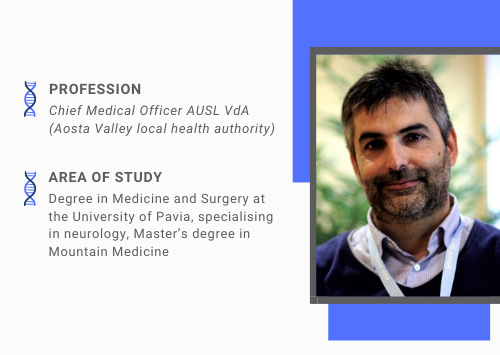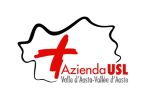Guido Giardini Interview

What is your role within the 5000genomi@VdA project?
In the project, I perform the role of clinical point of reference, as I will be mainly involved in creating a link and facilitating cooperation amongst all the partners and the Aosta Valley Local Health Authority (AUSL VdA). More specifically, I will have to coordinate the team of healthcare professionals and specialists from the AUSL VdA for the preliminary activities in the identification and recruitment of patients suitable for genome sequencing, and facilitating the collection, storage and handling of biological samples within the biobank.
What is AUSL’ VdAs contribution to the 5000genomi@VdA project?
The Local Health Authority (AUSL VdA) plays a fundamental role in all clinical procedures. The most suitable patients will be selected from those visiting our clinics, and they will be offered the possibility of an in-depth analysis of their DNA. In this way, the integration between the local health authority and CMP3VdA will lay the foundations for the development of, and access to, personalized medicine, in order to give people in the Aosta Valley, over the course of several years, a state-of-the-art health service, the only one of its type in Italy.
How was your team of experts contributing to the project formed, and who does it include?
Cross-functional teamwork, the sharing of medical and scientific expertise and the active involvement of the various specialists are fundamental in the 5000genomi@VdA project. It will also see the participation of Dr Marina Schena (Director of the Department of Oncology and Cancer Haematology), Dr Laure Obino (Manager of the Child Neuropsychiatry Department), Dr Pierluigi Berti (Director of the Department of Immunohaematology and Transfusion Medicine), Dr Familiari (Director of the Pathological Anatomy Department) and Dr Di Benedetto (Director of the Clinical Analysis Department). All these personalities will receive assistance from the young 5000genomi@VdA ESF research scholarship winners, who, once appropriately trained and supervised by specialist staff, will provide a direct link between wards and the laboratory.
What is the biobank that will be installed at the U. Parini Hospital?
A biobank is defined as a non-profit service unit for the collection, processing, storage and distribution of human biological samples and the respective data, for research and diagnostics processes. One will soon be installed at the U. Parini Aosta Valley Regional hospital in Aosta. It will comprise various instruments for the collection, conservation, storage and processing of patients’ biological samples that can be used for genome sequencing. It will contain different types of biological material: from tissue fragments from biopsies or surgical operations, to biological liquids (such as blood, saliva, cerebrospinal fluid, etc.) that will be collected and processed according to accepted protocols compliant with international reference standards so that they are available for all the analyses necessary to create clinical and molecular data that will successively become part of the patients’ digital health records.
Once they have been prepared and catalogued, the samples ready for DNA sequencing will be transferred to the CMP3VdA laboratories for analyses and “information digitalisation”: the data extracted will be analysed by the computational genomics groups (IIT and OAVdA) and stored in the Pont-Saint-Martin data centre provided by the partner company Engineering D.HUB. The biobank will be entirely managed by the local health authority (AUSL) with support from the CMP3VdA groups, and, at the end of the 5000genomi@VdA project, it will remain the property of the Region, available for the Health System.
You are also the Manager of the Mountain Medicine and Neurology clinic: could you explain what you do there?
Mountain Medicine is a branch of medicine that studies the human organism’s physiological reactions to high altitudes (over 1,500 m) and the related diseases that are possible at those heights. The only public clinic in Italy dedicated to this speciality is in the Aosta Valley: more specifically, we study the mechanisms that the human body uses for adaptation to the specific features of the mountain environment, which has distinctive, unique characteristics (lower oxygen levels, very low temperatures, and increase in solar radiation). For example, it is very interesting to study the biological processes involved in hypothermia (a condition commonly encountered in avalanche accidents) or the response to low oxygen concentrations (hypoxia), because all this information could be useful for researching new treatments and biotechnological solutions in other sectors of medicine, from strokes to heart attacks, from tumour development to neurodegenerative diseases. In fact, in science, certain cellular mechanisms can be shared by clinically different diseases, and therefore it is fundamentally important to learn about them and exploit them to best advantage. Lastly, Mountain Medicine also provides a therapeutic contribution for the treatment of chronic pathologies: indeed, it has been shown that for some diseases, such as high blood pressure and depressive disorders, being in the mountains and performing physical activity in this environment (so-called “mountain therapy”) offers benefits that improve prognosis and reduce the medication rate of prescribed drugs.
(interview: Sept 2020)




